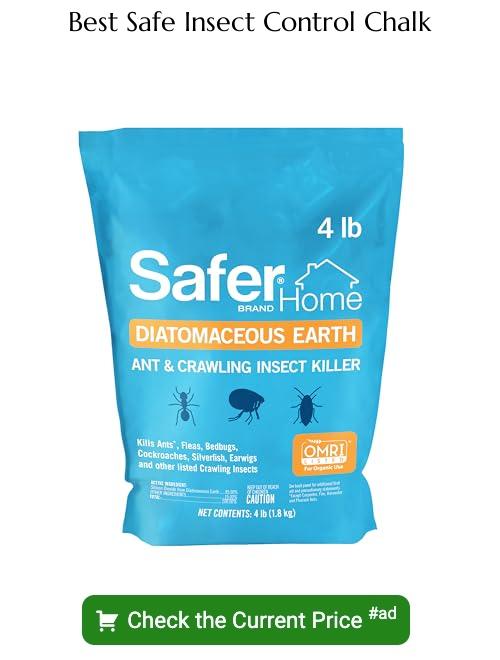Last updated on
Discover the uses and concerns surrounding Chinese chalk, an insecticidal tool often sought for its effectiveness against pests.
Key takeaways:
- Ant chalk is an insecticide used to control ant and roach populations.
- Chinese chalk contains deltamethrin and cypermethrin, which disrupt the nervous system of insects.
- Chinese chalk can pose health risks to humans and pets if handled improperly.
- Safer alternatives to Chinese chalk include diatomaceous earth and essential oils.
- Prioritize health and environmental considerations when dealing with pests.
What Is Ant Chalk?
Ant chalk, commonly known as Chinese chalk or miracle chalk, is an insecticide in stick form resembling regular chalk. Its primary use is to control ant and roach populations within households.
Users typically draw lines around entry points or insect paths, which insects then cross and pick up the toxic substances on their bodies. The active ingredients in ant chalk include deltamethrin and cypermethrin, which are synthetic pyrethroids designed to disrupt the nervous system of insects, leading to their eventual death.
Originating from China, this product gained popularity for its ease of use and the DIY approach to pest control. Despite its effectiveness, it is essential to note that these chalks are not authorized for use in all countries due to their potential health hazards, which will be discussed further in the subsequent sections.
Chemical Composition
Chinese chalk, often labeled as “Miraculous Chalk” or “Ant Chalk,” is a type of insecticide that contains several active ingredients which were traditionally used to control pests. The primary chemical in most formulations of this product is deltamethrin, which belongs to a class of insecticides known as pyrethroids that mimic the insecticidal activity of the natural compound pyrethrin found in chrysanthemum flowers. Pyrethroids work by attacking the nervous systems of insects, leading to paralysis and death.
In addition to deltamethrin, other compounds such as cypermethrin or propoxur may also be present, enhancing the product’s effectiveness against a broad range of pest species. Propoxur is a carbamate insecticide that similarly interferes with an insect’s nervous system by inhibiting a key enzyme, acetylcholinesterase. This enzyme’s inhibition leads to the accumulation of acetylcholine, causing continuous nerve signal transmission and eventually insect death.
Despite their effectiveness, the active substances in Chinese chalk can also pose significant risks to human and pet health if handled improperly. Due to these risks and the fact that Chinese chalk was often sold without proper labeling and guidance, such products have been largely banned or restricted in many countries.
Safety Concerns
Chinese chalk, often marketed as “Miraculous Chalk” or “Chinese Miracle Chalk,” contains the pesticides deltamethrin and cypermethrin, which are toxic to humans and pets if ingested.
The US Environmental Protection Agency (EPA) has deemed it illegal due to its health risks and the absence of usage directions in English.
Use around children or food surfaces heightens the risk of accidental ingestion.
Skin contact can cause irritation or allergic reactions, and inhalation of dust may aggravate asthma or other respiratory conditions.
Always use protective gear when handling any pesticides and thoroughly wash your hands afterwards.
Dispose of this product properly according to the regulations in your area.
Consider safer, EPA-approved alternatives for ant control to protect your household and environment.
Alternatives to Ant Chalk
Considering the health and environmental risks associated with ant chalk, it’s wise to explore safer and effective options. One eco-friendly choice is diatomaceous earth, a natural powder that dehydrates insects upon contact.
Essential oils like peppermint, tea tree, or citrus can deter ants with their strong scents when mixed with water and sprayed in affected areas.
Borax mixed with sugar creates a homemade bait that, when ingested, is lethal to ants but has a lower toxicity risk for humans and pets.
For those preferring a ready-to-use solution, commercial ant baits or gels designed with safety in mind offer convenience while targeting the ant colony source.
Finally, preventative measures such as sealing entry points and maintaining a clean environment reduce the attractiveness of your home to ants.
What You Should Do
If you’re considering using ant chalk, it’s important to first explore legal and safe alternatives for pest control. Look for products with clear labeling that lists active ingredients and follow the Environmental Protection Agency (EPA) guidelines. For a non-toxic approach, consider natural deterrents like diatomaceous earth or boric acid, which are effective against ants while being safer for household use.
Adopt preventative measures to keep ants at bay, such as sealing entry points, maintaining a clean kitchen, and managing waste effectively. Regularly clean surfaces and floors to remove food residues that attract ants.
In the event of an infestation, contact licensed pest control professionals who can provide effective treatment while ensuring the safety of your home environment. Always prioritize health and environmental considerations over convenience when dealing with pests.
Recap:





